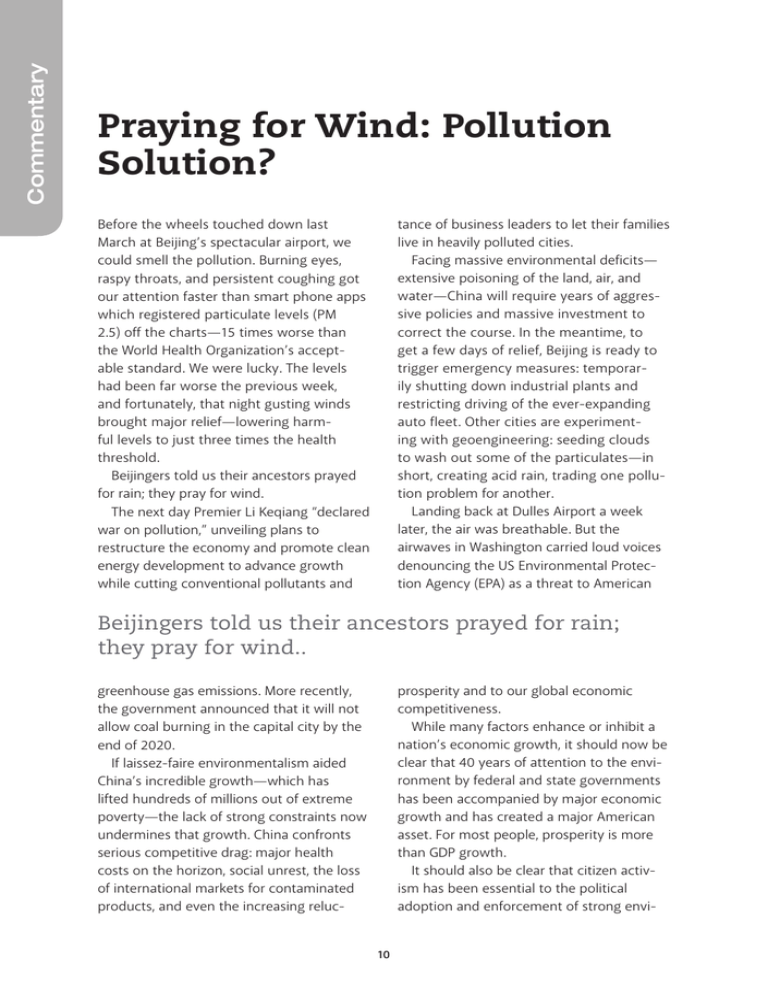Praying for Wind: Pollution Solution? Commentary
advertisement

Commentary Praying for Wind: Pollution Solution? tance of business leaders to let their families live in heavily polluted cities. Facing massive environmental deficits— extensive poisoning of the land, air, and water—China will require years of aggressive policies and massive investment to correct the course. In the meantime, to get a few days of relief, Beijing is ready to trigger emergency measures: temporarily shutting down industrial plants and restricting driving of the ever-expanding auto fleet. Other cities are experimenting with geoengineering: seeding clouds to wash out some of the particulates—in short, creating acid rain, trading one pollution problem for another. Landing back at Dulles Airport a week later, the air was breathable. But the airwaves in Washington carried loud voices denouncing the US Environmental Protection Agency (EPA) as a threat to American Before the wheels touched down last March at Beijing’s spectacular airport, we could smell the pollution. Burning eyes, raspy throats, and persistent coughing got our attention faster than smart phone apps which registered particulate levels (PM 2.5) off the charts—15 times worse than the World Health Organization’s acceptable standard. We were lucky. The levels had been far worse the previous week, and fortunately, that night gusting winds brought major relief—lowering harmful levels to just three times the health threshold. Beijingers told us their ancestors prayed for rain; they pray for wind. The next day Premier Li Keqiang “declared war on pollution,” unveiling plans to restructure the economy and promote clean energy development to advance growth while cutting conventional pollutants and Beijingers told us their ancestors prayed for rain; they pray for wind.. prosperity and to our global economic competitiveness. While many factors enhance or inhibit a nation’s economic growth, it should now be clear that 40 years of attention to the environment by federal and state governments has been accompanied by major economic growth and has created a major American asset. For most people, prosperity is more than GDP growth. It should also be clear that citizen activism has been essential to the political adoption and enforcement of strong envi- greenhouse gas emissions. More recently, the government announced that it will not allow coal burning in the capital city by the end of 2020. If laissez-faire environmentalism aided China’s incredible growth—which has lifted hundreds of millions out of extreme poverty—the lack of strong constraints now undermines that growth. China confronts serious competitive drag: major health costs on the horizon, social unrest, the loss of international markets for contaminated products, and even the increasing reluc- 10 © 145/Guy Vanderelst/Ocean/Corbis Air pollution obscures the view of Guangzhou and the Pearl River. In rejecting such extreme views, however, we must recognize that policy choices can have economic consequences and activists do not always have the right answers or a strong case for government action. The future of our economy is not clear, and policymakers must take care not to squander public or private resources. We must be smart about how we proceed. First and foremost, we should be guided by solid science as it continues to advance, whether dealing with small particulates, carbon dioxide, or radiation. In general, this is a requirement EPA must follow under the Clean Air Act, which historically has had strong bipartisan support. The abuse of science is not limited to those who deny the impact of pollutants; deliberately or inadvertently it arises among some activists. Second, policymakers should set priorities based on the assessment of risks so that we focus our resources on serious threats. Third, ronmental policies. Indeed, in China, where citizen organizing is highly restricted, the government has had to deal with extensive environmental riots and, in a new environmental law, has decided to allow certain registered groups to sue polluters in court. It can no longer fully control such activism in the era of social media. In the United States, citizens have access to government through elections, regulatory processes, and the courts. Citizen groups have been highly organized and periodically recharged when government and industry have failed to protect citizen health. Many loud critics of US environmental constraints are fundamentally wrong in their claims that economic growth is impaired. They call for stripping EPA of its long-standing authorities and blocking the avenues enabling citizens to be heard. Such proposals should be, and almost certainly will be, rejected. China should be a lesson for us. 11 China and the United States are in far different places, but the desire for prosperity by both requires continual attention to the intersection of the economy and the environment. this global challenge. Certainly the recent agreement undercuts the political factions in each country that have been justifying inaction by pointing to the failures in the other country—and it should help advance action by other nations as well. We have much to learn from each other. We have much to do together if we are to provide posterity with options beyond praying for wind. —Phil Sharp China and the United States are in far different places, but the desire for prosperity by both requires continual attention to the intersection of the economy and the environment. Neither nation has a guaranteed way to sustain economic growth with a healthy environment—but, to date, the United States has forged the more viable path. The winds of prosperity do not blow steadily and will turn against both countries if the two biggest emitters of greenhouse gases neglect their obligation to collectively This article orginally appeared on the Huffington Post’s The Blog, August 26, 2014. Tai Chi practitioners assemble against the backdrop of a polluted Shanghai skyline. © Robert Wallace/Corbis Commentary lead the global drive to mitigate climate disruption. The recent agreement between President Xi and President Obama represents an important pathway for partially addressing they should rely where possible on compliance strategies that are most cost-effective and likely to spur innovation. Finally, they should be willing to discard outdated or ineffective policies. 12






